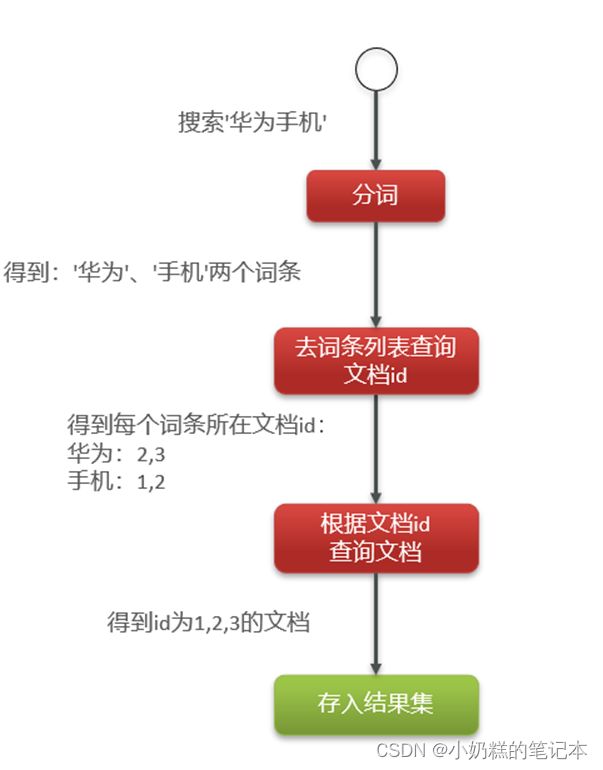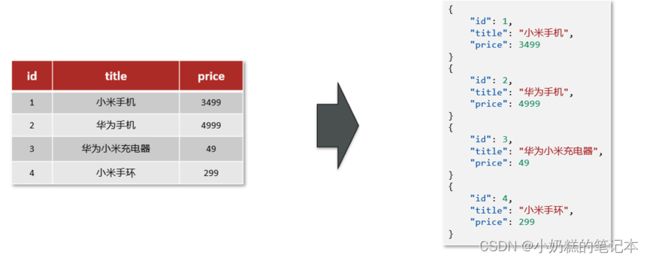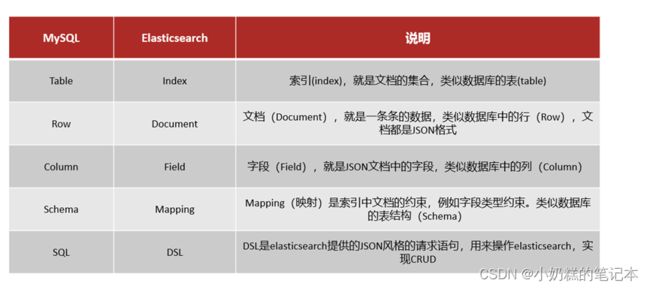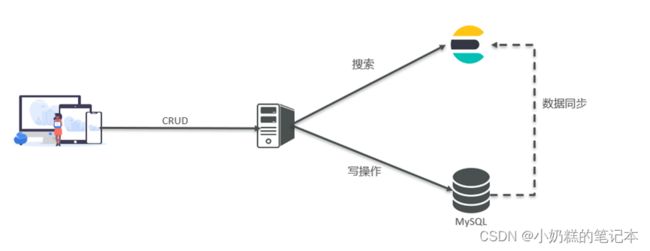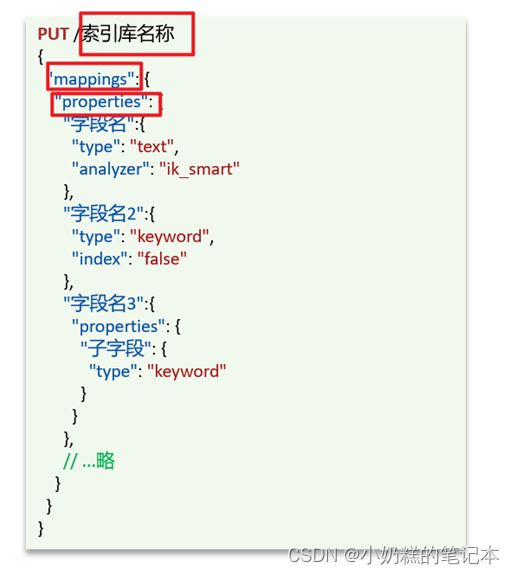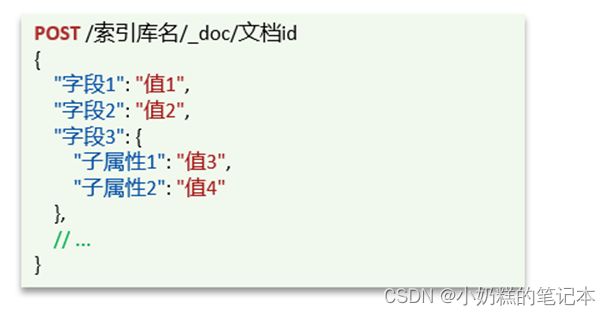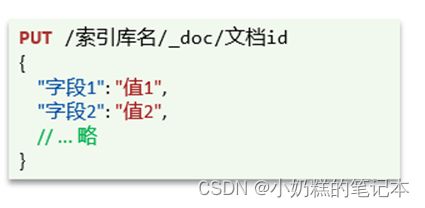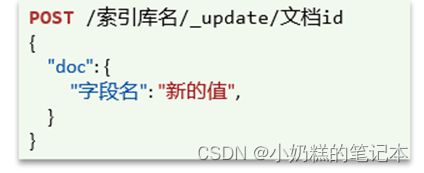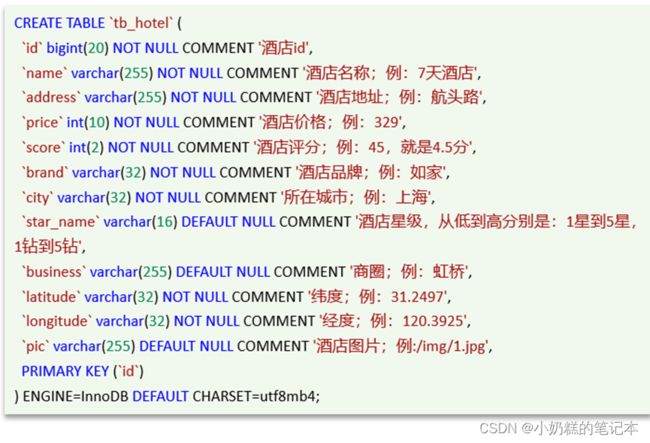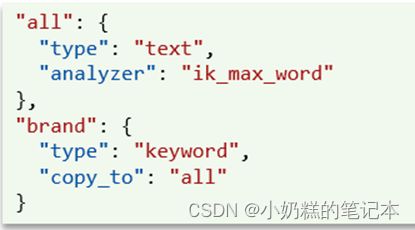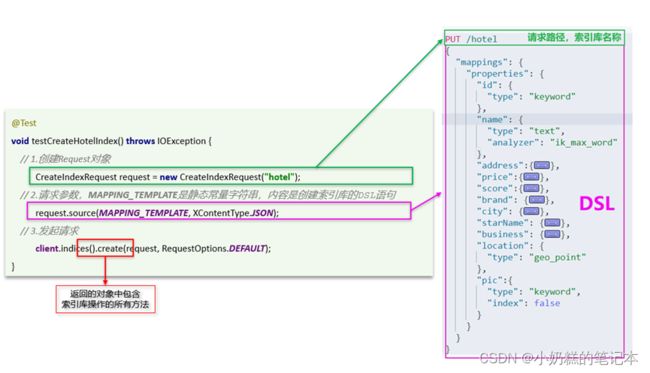05_es分布式搜索引擎1
一、初始elasticsearch
1.elasticsearch简单介绍
①什么是elasticsearch?
开源的分布式搜索引擎,实现海量数据搜索,日志统计,分析,系统监控等功能
②什么是elastic stack?
是以elasticsearch为核心的技术栈,包括beats,Logstash,kibana, elasticsearch
③什么是Lucene?
是Apache开源搜索引擎类库,提供搜索引擎的API
2.正向索引和倒排索引
①什么是文档document和词条term?
文档:每一条数据就是文档
词条:对文档的内容分词
②什么是正向索引?
基于文档id创建索引,查询词条时必须找到文档,然后判断该文档是否包含词条。
③什么是倒排索引?
对文档内容进行分词,对词条创建索引,并记录词条所在文档的信息。
搜索时要进行分词,然后去词条列表查询文档id,通过文档id查询文档,把结果存放在结果集。
④倒排索引的组成
词条词典:记录所有词条, 词条和倒排列表PostingList之间关系。给词条创建索引,提高查询和插入效率
倒排列表PostingList:记录词条所在的文档id,词条出现频率,词条在文档的位置
3.ES的基本概念
①索引index:
同类型文档的集合。类似Mysql的表table
②文档document:
一条数据就是一个文档,文档数据在es是Json格式。类似Mysql的行row
③字段field:
Json文档的字段。类似Mysql的列
④映射Mapping:
字段的类型约束信息,类似表的结构约束
4.ES-MySQL的架构
ES:海量数据搜索
Mysql:事务操作,数据安全性和一致性
二、索引库操作
1.索引库 (建表)的概念
①mapping是对文档字段的约束。
②mapping约束的属性
type:字段类型(
字符串:text(分词)、keyword(不分词)
数字:long、integer、short、byte、double、float
布尔:boolean
日期:date
对象:object
index:该字段是否用约束,默认true
analyzer:使用的分词器
properties:该字段下的子字段
2.创建索引库
ES通过Restful请求操作索引库和文档。请求内容通过DSL语句表示
创建索引库:创建一个索引库heima,有字段info,email,name有子字段firstName, lastName
# 创建索引库heima
PUT /heima
{
"mappings": {
"properties": {
"info":{
"type":"text",
"analyzer":"ik_smart"
},
"email":{
"type": "keyword",
"index": false
},
"name":{
"type": "object",
"properties": {
"firstName":{
"type":"keyword"
},
"lastName":{
"type":"keyword"
}
}
}
}
}
}
查看索引库:GET /索引库名
删除索引库:DELETE /索引库名
添加索引库字段:PUT /索引库名/_mapping
PUT /heima/_mapping
{
"properties":{
"age":{
"type":"integer"
}
}
}
3.文档操作(添加数据)
①增
POST /heima/_doc/1
{
"age": 20,
"info": "这是学生",
"email": "[email protected]",
"name": {
"lastName": "wang",
"firsrName":"zhi"
}
}
②删
DELETE /索引库名/_doc/文档id
③改
方式一:根据主键值id全量修改,删除旧文档,新增以下字段文档。此时只有age
PUT /heima/_doc/1
{
"age": 10
}
方式二:修改某个字段值,只把年龄修改
POST /heima/_update/1
{
"doc":{
"age": 10
}
}
④查
GET /索引库名/_doc/文档id
GET /heima/_doc/1
4.文档操作有哪些?
- 创建文档:POST /索引库名/_doc/文档id { json文档 }
- 查询文档:GET /索引库名/_doc/文档id
- 删除文档:DELETE /索引库名/_doc/文档id
- 修改文档:
全量修改:PUT /索引库名/_doc/文档id { json文档 }
增量修改:POST /索引库名/_update/文档id { "doc": {字段}}
三、RestClient操作索引库
1.什么是RestClient
RestClient本质是组装DSL语句,通过http请求发送ES
2.利用JavaRestClient实现创建、删除索引库。判断索引库是否存在
步骤1:导入资料包hotel-demo
步骤2:分析数据结构
①mapping要考虑问题:字段名,数据类型type,是否搜索index,是否分词analyzer(分词器)
# 酒店的mapping
PUT /hotel
{
"mappings": {
"properties": {
"id":{
"type": "keyword"
},
"name":{
"type": "text",
"analyzer": "ik_max_word"
},
"address":{
"type": "keyword",
"index": false
},
"price":{
"type": "integer"
},
"score":{
"type":"integer"
},
"brand":{
"type":"keyword"
},
"city":{
"type":"keyword"
},
"starName":{
"type":"keyword"
},
"business":{
"type":"keyword"
},
"location":{
"type":"geo_point"
},
"pic":{
"type":"keyword",
"index":false
}
}
}
}
修改:把全部搜索的字段组合放在all字段
# 酒店的mapping
PUT /hotel
{
"mappings": {
"properties": {
"id":{
"type": "keyword"
},
"name":{
"type": "text",
"analyzer": "ik_max_word",
"copy_to": "all"
},
"address":{
"type": "keyword",
"index": false
},
"price":{
"type": "integer"
},
"score":{
"type":"integer"
},
"brand":{
"type":"keyword",
"copy_to": "all"
},
"city":{
"type":"keyword"
},
"starName":{
"type":"keyword"
},
"business":{
"type":"keyword"
},
"location":{
"type":"geo_point"
},
"pic":{
"type":"keyword",
"index":false
},
"all":{
"type": "text",
"analyzer": "ik_max_word"
}
}
}
}
步骤3:初始化JavaRestClient
①导入es依赖
org.elasticsearch.client
elasticsearch-rest-high-level-client
7.12.1
②初始化RestHighLevelClient:
public class HotelIndexTest {
private RestHighLevelClient client;
@Test
void testInit(){
}
@BeforeEach
void setUp() {
this.client = new RestHighLevelClient(RestClient.builder(
HttpHost.create("http://192.168.137.129:9200")
));
}
@AfterEach
void tearDown() throws IOException {
this.client.close();
}
}
所有的单元测试,先运行@BeforeEach再@Test,最后@AfterEach
步骤4:
MAPPING_TEMPLATE
public class HotelConstants {
public static final String MAPPING_TEMPLATE =
"{\n" +
" \"mappings\": {\n" +
" \"properties\": {\n" +
" \"id\":{\n" +
" \"type\": \"keyword\"\n" +
" },\n" +
" \"name\":{\n" +
" \"type\": \"text\",\n" +
" \"analyzer\": \"ik_max_word\",\n" +
" \"copy_to\": \"all\"\n" +
" },\n" +
" \"address\":{\n" +
" \"type\": \"keyword\",\n" +
" \"index\": false\n" +
" },\n" +
" \"price\":{\n" +
" \"type\": \"integer\"\n" +
" },\n" +
" \"score\":{\n" +
" \"type\":\"integer\"\n" +
" },\n" +
" \"brand\":{\n" +
" \"type\":\"keyword\",\n" +
" \"copy_to\": \"all\"\n" +
" },\n" +
" \"city\":{\n" +
" \"type\":\"keyword\"\n" +
" }, \n" +
" \"starName\":{\n" +
" \"type\":\"keyword\"\n" +
" },\n" +
" \"business\":{\n" +
" \"type\":\"keyword\"\n" +
" },\n" +
" \"location\":{\n" +
" \"type\":\"geo_point\"\n" +
" },\n" +
" \"pic\":{\n" +
" \"type\":\"keyword\",\n" +
" \"index\":false\n" +
" },\n" +
" \"all\":{\n" +
" \"type\": \"text\",\n" +
" \"analyzer\": \"ik_max_word\"\n" +
" }\n" +
" }\n" +
" }\n" +
"}\n";
}①创建索引库
@Test
void createHotelIndex() throws IOException {
// 1.创建request对象(索引库)
CreateIndexRequest request = new CreateIndexRequest("hotel");
// 2.请求参数(mapping)
request.source(MAPPING_TEMPLATE, XContentType.JSON);
// 3.发送请求(创建)
client.indices().create(request, RequestOptions.DEFAULT);
}
②查询索引库是否存在
@Test
void getHotelIndex() throws IOException {
// 1.创建查询对象
GetIndexRequest request = new GetIndexRequest("hotel");
// 2.执行查询
Boolean response = client.indices().exists(request, RequestOptions.DEFAULT);
System.out.println(response);
}
③删除索引库
@Test
void deleteHotelIndex() throws IOException {
// 1.创建删除对象
DeleteIndexRequest request = new DeleteIndexRequest("hotel");
// 2.执行删除
client.indices().delete(request,RequestOptions.DEFAULT);
}
索引库操作的基本步骤:
- 初始化RestHighLevelClient
- 创建XxxIndexRequest。XXX是Create、Get、Delete
- 准备DSL( Create时需要)
- 发送请求。调用RestHighLevelClient#indices().xxx()方法,xxx是create、exists、delete
四、RestClient操作文档
1.添加文档client.index()
①查询数据库里面ID号为38609酒店信息
②把查询的信息转换为json插入,id从信息里面获取
@Test
void testIndexDocument() throws IOException {
// 1.根据id查询
Hotel hotel = hotelService.getById(38609L);
// 转换为文档数据
HotelDoc hotelDoc = new HotelDoc(hotel);
// 2.创建request对象
IndexRequest request = new IndexRequest("hotel").id(hotelDoc.getId().toString());
// 创建JSON文档
request.source(JSON.toJSONString(hotelDoc), XContentType.JSON);
// 发送请求
client.index(request, RequestOptions.DEFAULT);
}
2.查询文档client.get()
@Test
void testGetIndex() throws IOException {
// 查询请求
GetRequest request = new GetRequest("hotel","38609");
// 发送请求
GetResponse response = client.get(request, RequestOptions.DEFAULT);
// 获取结果_source的JSON
String json = response.getSourceAsString();
// JSON转换为对象
HotelDoc hotelDoc = JSON.parseObject(json, HotelDoc.class);
System.out.println(hotelDoc);
}
3.更新文档client.update()
@Test
void testUpdate() throws IOException {
// 更新请求
UpdateRequest request = new UpdateRequest("hotel","38609");
// 更新字段 K,V 逗号隔开
request.doc(
"price","666",
"starName","四钻"
);
// 执行更新
client.update(request,RequestOptions.DEFAULT);
}
4.根据ID删除文档
@Test
void testDelete() throws IOException {
// 删除请求
DeleteRequest request = new DeleteRequest("hotel","38609");
// 执行删除
client.delete(request,RequestOptions.DEFAULT);
}
5.批量导入数据BulkRequest
@Test
void testBulk() throws IOException {
// 查询数据
List hotels = hotelService.list();
// 创建Request
BulkRequest request = new BulkRequest();
// 批量数据
for (Hotel hotel : hotels) {
HotelDoc hotelDoc = new HotelDoc(hotel);
request.add(new IndexRequest("hotel")
.id(hotelDoc.getId().toString())
.source(JSON.toJSONString(hotelDoc),XContentType.JSON));
}
// 执行添加
client.bulk(request,RequestOptions.DEFAULT);
}
6.总结文档操作步骤
- 初始化RestHighLevelClient
- 创建XxxRequest。XXX是Index、Get、Update、Delete
- 准备参数(Index和Update时需要)
- 发送请求。调用RestHighLevelClient#.xxx()方法,xxx是index、get、update、delete
- 解析结果(Get时需要)


